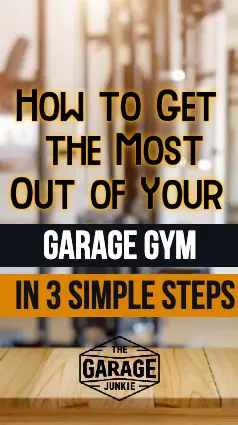Going to the gym is like drinking a kale-spinach smoothie, sure it’s good for you, but who wants to do it? Paying a monthly membership for the privilege of working out with a bunch of sweaty strangers is hardly anyone’s idea of fun. Yet, everyone knows that working out is key to maintaining a healthy lifestyle. So, what is one to do? Luckily, there has been an explosion of interest in creating home gyms.

And while you may think you don’t have space for a gym in your home, you almost certainly do. You can take advantage of an often-underutilized space in most homes, your garage.
Setting up a garage gym isn’t as easy as just throwing a couple of weights next to your car and calling it a day, however, maximizing your space will require some careful planning and forethought. When done properly, the benefits of being able to get a high-quality workout without ever having to leave your home are well worth it. The convenience of a garage gym is easily attainable, as you will see below, in our step-by-step guide to maximizing your garage gym in just three easy steps.
With just a minimal amount of planning, some home gym essentials, and a few pieces of workout equipment, you’ll be sweating your behind off in the privacy of your own garage gym sooner than you think. Sound good? Read on to see how you can make it happen.
1) Assess Your Space
The first thing you should do when setting up your garage gym is assess the space you have and how best to use it. When assessing your space, it can be helpful to ask yourself the following questions:
- What total area do you have available for your garage gym and how can you best utilize it.
- What is the heating and cooling situation in your garage, think of the temperature in all seasons.
- Where is there access to electricity if needed?
- How permanent are you willing to make your garage gym area, will you be putting everything away after every use?
- Where will the equipment be stored when not in use? Can you store equipment in other areas of the house when not working out?
- Who will be using the garage gym and what are their specific needs?
With these questions in mind, we can quickly figure out how to maximize your space for a garage gym.
For example, let’s say you have a two-car garage available to use for your gym, you may choose to use one of the parking spaces as space for your gym. This should be a roughly five-by-ten-foot area, with plenty of room for your garage gym. The garage is insulated but may require a heater in the winter or a fan in the summer. If you have access to an electrical outlet nearer to one of the parking spots (and you need electricity for your gym) use that particular parking spot. If you don’t need your additional parking space frequently, you may choose to make your gym more permanent and not break down or put away all the equipment after every use. Lastly, consider the needs of your garage gym’s users, this will determine the mix of equipment you will need. For example, those that want to do circuit training will need a combination of both cardio and weighted items.
2) Outfit Your Garage Gym With the Essentials
No matter what your space looks like, or how you choose to fill it with equipment, every garage gym will need a few of the same essential pieces. These items can be important for your gym for a variety of reasons such as safety and comfort.
A few items that everyone should consider adding to their garage gym follow below:
Padded Flooring:
The foundational element for any garage gym is some sort of padded flooring, like these interlocking-gym tiles from Xspec. Make sure that your padding is at least half an inch thick, as anything less will provide a less-than-optimal cushion. Having such flooring is not only useful in lessening noise but also in providing a safe non-slip surface for your workouts. The flooring will also keep you from damaging the floor of your garage or your equipment.
Air Circulator or Heater:
Whether you require heating or cooling in your garage gym will largely depend on the season and state of your own garage’s insulation. However, every gym should have some form of a fan to increase airflow and circulation while working out. A good option that takes up minimal space and moves a prodigious amount of air is this blower from Lasko. Often used on construction job sites, this fan will be perfect for those who need to vent or cool their garage gym. If you need a heater for your garage gym, a portable ceramic heater, like this one, can be a great option to provide supplemental warmth for chilly garages.
A Mirror:
One of the most overlooked essentials for any garage gym is a mirror. Having a mirror in your garage is important as it will allow you to check your posture and form when working out. Without this ability, you will have no way to correct yourself and may form bad habits that could lead to injury. The mirror doesn’t need to be overly large or expensive and it doesn’t even need to be permanently affixed around your garage. In fact, if you would like to borrow a mirror from another part of your house feel free to. If you are looking for a mirror specifically for your garage gym, however, a full-length mirror or two should do just fine, (this mirror may be a good choice).
3) Decide on Your Equipment
Whatever equipment you choose to fill out your garage gym with will ultimately depend on what the needs of your workouts usually are. For example, a regular pilates routine and a CrossFit program will require very different equipment. So, consider your own needs before making any purchases.
But the equipment below should be useful for a variety of workout styles and all of it compacts in some form, which is great for a garage gym:
Free Weights:
A set of weights or dumbbells is almost a must for any garage gym due to the sheer number of ways they can be utilized for different workouts. An adjustable set of dumbbells, like those found here, may be especially useful for those short on space, as they are adjustable, which means you will have fewer dumbbells to worry about storing overall. Free weights are great because they are portable and can be easily added to existing workout routines to provide additional resistance and load.
Weight Bench:
A weight bench is good for more than just weight training, as it can be an essential part of any cardio or circuit training program. A bench that has the ability to incline, like this one, is good for those that are looking to accomplish full-range of motion exercises. Be sure to look out for features like leg braces, which will make it easier to do crunches or weighted sit-ups, if those exercises are important to you.
Pull-up Bar:
Even if you don’t think you will ever be able to do a pull-up yourself, you should still consider getting a pull-up bar. This is because they are truly versatile pieces of equipment that take up almost no space and even just doing a flexed-arm-hang from one is quite the full-body workout. And pull-up bars can be easily placed inside the doorway to your garage, like this one from Pathonor. Be sure to get one with multiple grips in order to best work out major muscle groups like your arms, back, and shoulders.
Cardio Machine:
If you think you need lots of space for a cardio machine like a treadmill or stair-stepper, think again. These days, you can find miniature versions of almost any piece of cardio equipment you could desire. One particularly compact machine is this mini stair-stepper from Sunny Health, which also features resistance bands so you can work your arms as you step. While you may think that a cardio machine is an unnecessary splurge, some sort of cardio equipment is very much necessary. This is especially true for anyone looking to lose weight from their workouts, as adding cardio to a strengthening routine is a simple way to ensure weight loss.
Suspension Trainer System:
A suspension trainer is another great piece of equipment that can be incorporated into a variety of workouts. Suspension trainer systems (such as this Jungle Gym XT from Lifeline) are great ways to workout muscle groups like your shoulders, upper back, chest, and arms. Just like a pull-up bar, most suspension trainers can be easily installed in any doorway in a matter of minutes. And the best part is that because such systems rely on tension and bodyweight alone to provide a workout, they can be packed away to almost nothing when not in use.
4) Conclusion
So by now, we hope you agree that setting up your own garage gym is not an impossible or even difficult task. In fact, if you follow the advice above, you should be able to set up your garage gym in a matter of hours without having to permanently alter your garage in any way. It may require some initial investment in order to get the right workout equipment, but everything we have listed here is versatile enough to be useful for a wide variety of workout styles. But besides that, the amount you need to invest in your garage gym will quickly be repaid to you through savings from not having gym memberships, etc.
Most importantly, your garage gym will be a great return on the investment in your health. We hope you have enjoyed reading about how to maximize your own garage gym and that you have learned something new in the process. Please don’t forget to check out the rest of our site, The Garage Junkie, for more great tips on garage storage, specialties, organization, and security.
